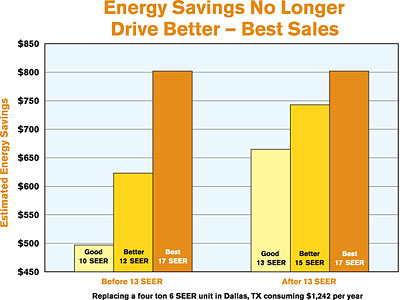The new minimum efficiency standard has rendered the compromise choice good-better-best sales approach an inferior way to sell comfort to today's consumers. The once high-margin premium product, 13 SEER, is now a basic commodity sold on price in every market in America.
Low-price leaders now sell the "best" every day. Skyrocketing entry-level equipment costs have made thousand dollar repairs the new "good" choice. And contractors who continue manipulating buyers towards the "better" choice will watch as sales, customer satisfaction, and profits erode.
PREMIUM SALES WILL BE LOST
TheHarvard Business Reviewstory went on to state, "The important thing to recognize is the product you really want to sell should be positioned in the middle. The high-end product is there mainly to pull people toward the compromise choice."It's reckless to embrace a sales process designed to pull buyers away from premium products. Only premium products produce premium comfort and buyer satisfaction. Companies whose mission is providing premium comfort have lower worker turnover, higher morale, and superior profits.

SAVINGS NO LONGER DRIVE BETTER SALES
Research at Stanford University revealed, "Compromise effect relies on easy to comprehend choice options."In other words, the differences between good, better, and best must be easy for the buyer to immediately recognize and understand - things like soda serving sizes, computer speed, and memory space. Air conditioning, unfortunately for those selling good-better-best, doesn't meet the easy to comprehend requirement.
Before the 13 SEER standard, this complex problem wasn't apparent because most contractors used the one thing everyone recognizes and understands - money - in the form of energy savings. The energy savings realized by moving from a 10 SEER to a 13 SEER unit in many cases more than paid for the upgrade. Buyers in many climates today can't financially justify moving beyond 13 SEER because higher energy savings will no longer offset higher equipment costs.
Moving beyond 13 SEER now requires selling comfort, not energy savings. Because comfort is part product, part service, and part experience, it is not easy to define and definitely does not meet the easy to comprehend requirement.
HEALTH IS NOT A COMPROMISE CHOICE
Behavioral studies show buyers respond negatively when products critical to life, health or safety are sold using trinary choice. Doctors will never give patients a good-better-best surgery option.Our industry is starting to fully understand the amazing opportunity we have to improve quality of life through precise IAQ and moisture control. According to the American College of Allergists, "50 percent of illnesses are caused or aggravated by poor indoor air quality."
The American Society of Otolaryngology stated, "Proper humidity reduces the incidence of respiratory infections and speeds recovery from the common cold." When it comes to selling products and systems that affect health, life, and safety, good-better-best is a very bad choice.
WHEN RISK IS HIGH, PEOPLE WON'T BUY
Buying a new comfort system is one of the most risky, expensive, long-term decisions consumers will make. The risks buyers face include: Functional risk - will it work? Monetary risk - will it save? Physical risk - will it harm? Social risk - what will friends think? Psychological risk - will I regret it? On top of these, add the fact that there is no trade-in value if they buy the wrong one.According to research conducted by the Wharton School, University of Pennsylvania, "Risky options are not good candidates for the compromise effect. The middle option is not the safest because it contains intermediate risk."
About 2,400 years ago, Aristotle gave us a much better sales process than good-better-best when he said, "Men do not resist their ideas." Instead of giving three choices, the seller should assist the buyer in developing the right choice for them. The Wharton study went on to say, "When the buyer develops the solution, the options appear less risky."
COMFORT ISN'T A PRODUCT
The No. 1 reason good-better-best worked pre-13 SEER is the vast majority of sales were air conditioning units, not comfort systems. Typically, an outdoor product was hooked to the existing indoor coil, refrigerant lines, and electrical system.Today, 75 percent of what a contractor sells isn't a product. Unless the right people, with the right expertise, correctly install the right components, the buyer will not get the capacity, efficiency, and comfort they paid for. In fact, the system may not work at all. One of the quickest ways to lose credibility, sales, and profits is asking informed buyers to choose between a good, better, or best installation.
Steve Howard is the founder of The ACT Group. He can be reached at 602-678-1055 or by e-mail at steve@nopressureselling.com.
Publication date: 06/19/2006




